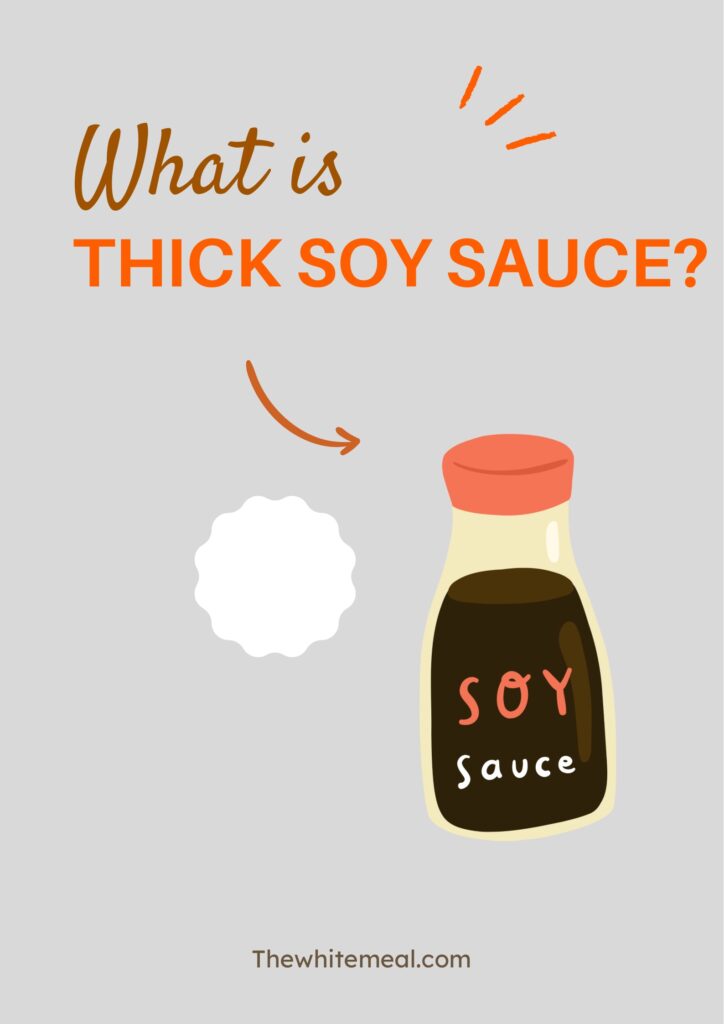Soy sauce is a pantry staple for many, but have you ever stumbled upon a recipe calling for thick soy sauce and wondered what it’s all about?
Don’t be too stunned, it’s a type of soy sauce with a different kind of makeup for slightly different uses.
This article will do justice to explaining what thick soy sauce is, its composition, comparisons with other soy sauces and uses.
Without wasting time, let’s get to it.

What Is Thick Soy Sauce? And What Is It Made Of?
Thick soy sauce is a variation of dark soy sauce that has been thickened through the process of heating it, and from the addition of heat, sugar and starch thickeners.
The end result is a luscious, extra-thick and velvety sauce boasting complex flavors perfect for adding dimension to your dishes or mastering the popular Chinese slow-braising technique known as red cooking.
At its core, thick soy sauce shares many similarities with traditional dark soy sauce, in fact, it’s made directly from it, so it’s safe to say that the sauce is a derivative!
Both are crafted from cultured boiled and roasted soybeans and wheat respectively) which are then wet fermented in a salt brine or dry fermented in coarse salt solution for an extended period.
This lengthy fermentation process yields a darker color along with richer, deeper and less salty flavors that distinguish these sauces from their lighter kin.
In some cases, additional ingredients such as MSG or molasses may be incorporated into thick soy sauces to further enhance their taste profile.
What Is Thick Soy Sauce Used For?
Thick Soy Sauce is mostly used for the following applications.
As a Finishing Sauce
One of the key uses for thick soy sauce is as a finishing touch to meals. Simply drizzle a little quantity of it over grilled meats, rice, noodles or vegetables for an extra layer of goodness that will leave a sweet savoury tinge on your taste buds.
Soups, Stews & Gravy
Soy sauce can also be used to add depth to soups and stews, especially when you’re making them with very few boring ingredients.
Stir-Fry Essential
Speaking of stir-fries, thick soy sauce truly shines when incorporated into these fast-paced dishes. Its consistency allows it to coat ingredients evenly while providing a delightful balance between sweetness and saltiness – making every bite an explosion of flavor.
Dipping Delight
For those who prefer their sauces on the side, thick soy sauce makes for an excellent dipping companion because of its less salty profile compared to regular soy sauce (especially when paired with scallions and ginger). It pairs well with dumplings, spring rolls, eggs and even sushi – offering a subtle hint of sweetness that complements each dish perfectly.
Red Braising Brilliance
Last but not least, let’s not forget about red braising – a popular Chinese cooking technique that relies on thick soy sauce’s unique properties. The sweet flavor and deep color imparted by this special ingredient give braised meats or tofu an enticingly rich red hue while enhancing their overall taste profile.
What Is The Difference Between Thick And Light Soy Sauce?
Production Techniques
Light soy sauce is made by fermenting a cultured grain mixture consisting of cooked soybeans and roasted wheat. Sometimes the roasted wheat is omitted especially when dark soy sauce is intended to be made.
This mixture isn’t left to ferment for an extended period, although it can undergo double fermentation (albeit still shorter in duration) to achieve more complex flavors.
The result is a liquid that boasts a high salt content (because of the brine it’s soaked in and the fact that it’s left to ferment only for short periods), lighter color and less pronounced flavors.
Thick soy sauce, on the other hand, starts its journey as dark soy sauce – primarily produced using the dry ferment method which covers the grain mixture with coarse salt instead of soaking the mixture in a brine solution a.k.a wet fermentation, and allows it to sit for longer periods.
To transform it into thick soy sauce, it’s then subjected to heat and mixed with sugar, MSG and thickeners for added body and depth of flavor.
Flavor Profiles: Salty vs Sweet
The final products couldn’t be more different when it comes to taste. Light soy sauce has an intensely salty profile with subtle flavors compared to the sweeter experience and richer notes of the thick soy sauce.
The latter also has lesser salt content thanks to prolonged fermentation while also boasting a darker hue.
Culinary Uses: Seasoning vs Dipping Sauce
Given their unique compositions, thick and light soy sauces have somewhat distinct applications in cooking.
Light soy sauce shines as a seasoning due to its saltiness; plus its lighter color ensures minimal impact on your dish’s appearance.
Conversely, thick soy sauce excels as a dipping or finishing element in recipes requiring depth in both color and flavor.
Is Thick Soy Sauce The Same As Oyster Sauce?
While thick soy sauce and oyster sauce share some similarities in terms of their usage in cooking – both adding depth of flavor – they are fundamentally different ingredients with unique tastes.
Let’s begin with the way that they’re made.
Thick soy sauce is made by fermenting soybeans and wheat with mold strains for an extended period of time, as we have mentioned above.
This process results in a thicker, darker-colored liquid with a rich, sweet taste.
Oyster sauce on the other hand, is a savory sauce made from oyster extracts combined with sugar, salt cornstarch (for thickening), and sometimes even soy sauce.
Its unique umami-rich flavor profile lends itself well to enhancing various dishes such as vegetables, stir-fries or noodle recipes.
Is Thick Soy The Same As Sweet Soy?
When it comes to the difference between thick soy sauce and sweet soy sauce (also known as Kecap manis), it’s best to consider the latter as a type of thick soy sauce.
Sweet soy sauce is made in the same basic way that thick soy sauce is made, except that this time around, the sweetening element comes from the generous addition of palm sugar.
Such addition lends it a syrupy consistency, making it ideal for glazing meats or vegetables while adding both sweetness and savory umami notes.
Sweet soy is most commonly associated with Indonesian cuisine and is enjoyed there with several dishes such as nasi goreng and semur beef stew.
Thick Soy Sauce Substitutes
If it happens that you run out of thick soy sauce or don’t know where to find it, you can always rely on some of these substitutes to replace thick soy sauce in your dish.
Dark Soy Sauce
When thick soy sauce is nowhere to be found, turn to its close relative the dark soy sauce.
Thick soy sauce, besides, is a direct derivative of dark soy sauce — with a slightly thicker texture, so it works incredibly well.
Light soy sauce + Brown Sugar + molasses
Light soy sauce on its own is thinner and saltier than its thicker counterpart, but when you add brown sugar and a hint of molasses to the mix, you can easily replicate the sweetness found in thick soy sauce as well as the signature viscosity that makes thick soy sauce so special.
To create this homemade thick soy sauce substitute with light soy sauce:
- Heat up light soy sauce on a pan until simmering, then gradually add brown sugar to the mix until the sauce thickens up.
- Make sure to stir well until all ingredients are thoroughly blended, and be careful not to use too much sugar, as a little would go a long way in thickening your soy sauce.
Where To Buy Thick Soy Sauce?
When you’re on the hunt for thick soy sauce to enhance your favorite dishes, it’s essential to know where to look.
Here are some places.
Grocery Stores
For the first place, I’d say the nearest grocery stores. They are an excellent place to start with when searching for thick soy sauce.
Head over to the international or Asian food aisle where they stock various sauces and condiments from around the world. Keep an eye out for brands like Kikkoman or Lee Kum Kee that offer high-quality options.
Specialty Asian Markets
If you have access to a specialty Asian market in your area, it’s definitely worth checking out their selection of thick soy sauces as well! These stores often carry a more extensive range of authentic soy sauces imported directly from Asia.
Online Retailers
If brick-and-mortar shopping isn’t yielding results, consider turning your search online! Websites like Amazon, Walmart, Walgreens, Target or even dedicated online retailers such as asianfoodgrocer.com offer an impressive variety of thick soy sauces available for delivery right at your doorstep.
Remember that while searching for “thick” soy sauce specifically might not always yield results under that name.
Other terms like “dark” or “sweet” soy sauce are often used interchangeably and could help you locate the same product.
More On Soy Sauce
Can You Make Soy Sauce Thicker?
Yes, you can make soy sauce thicker by mixing in cornstarch slurry to a simmering soy sauce on a pan until it gains depth. You can also use flour or brown sugar for that purpose.
Here’s the full procedure for both methods.
Cornstarch Slurry Method
One popular way to thicken soy sauce is by using a cornstarch slurry. This simple mixture of cornstarch and water can be added directly to simmering soy sauce, resulting in an almost instant thickening effect. Here’s how it’s done:
- Combine cornstarch with cold water in a small container and stir to fully dissolve the cornstarch and form a smooth slurry.
- Slowly pour the slurry into your simmering soy sauce while stirring continuously.
- Allow the mixture to cook for about 5 minutes or until it reaches your desired thickness.
If you don’t have cornstarch on hand, feel free to use rice flour, potato flour and even regular all-purpose flour.
The Brown Sugar Method
Another option for thickening your soy sauce is by incorporating brown sugar into the mix. This approach will led you to a sauce reminiscent of the dark or thick variety.
For this method:
Begin by heating up your desired amount of soy sauce in a small pot over medium heat until it simmers.
Gradually add brown sugar, stirring constantly until it dissolves completely.
Continue to simmer the mixture until it reaches your preferred thickness, keeping in mind that the sauce will thicken slightly as it cools.
Eliminate Water From The Sauce
By far the easiest way to thicken up light soy sauce without fortifying it with extra ingredients is to remove as much water from it as possible.
You can achieve this by simmering the light soy sauce over low to medium heat until you starts to thicken up.

